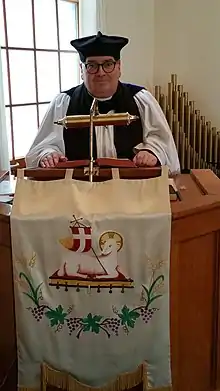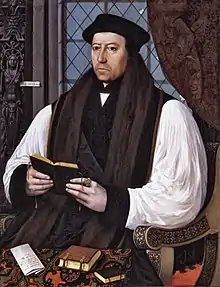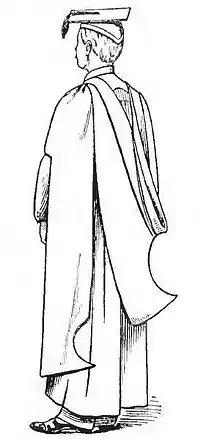Canterbury cap
The Canterbury cap is a square cloth hat with sharp corners found in the Anglican Communion. It is also soft and foldable, "Constructed to fold flat when not in use ..."[1] The Canterbury cap is the medieval birettum, descended from the ancient pileus headcovering. It is sometimes called the "catercap".

In Anglican churches, clergy are entitled to wear the cap, which is worn for processions and when seated to listen to Scripture or to give a homily, but not when at the Holy Table . It forms part of the "canonical" outdoor clerical dress, along with cassock, gown, and tippet.[2] The cap is made of black velvet for bishops and doctors, otherwise of black wool.[3]
In 1899, Percy Dearmer wrote in The Parson's Handbook:
The Cap, or 'square cap,' may have had its origin in the almuce. For the almuce was originally used to cover the head, and when it ceased to fulfil that function the cap seems to have been introduced. It has gone through several modifications: once of the comely shape that we see in the portraits of Bishop Fox and others, it developed in the seventeenth century into the form sometimes called the Canterbury cap (of limp material, with a tuft on the top), and then into the still beautiful college-cap in England, and abroad into the positively ugly biretta. There is no conceivable reason for English churchmen to discard their own shape in favour of a foreign one, except that the biretta offends an immense number of excellent lay folk, and thus makes the recovery of the Church more difficult.[4]
A similar cap called the Oxford soft cap is worn today as part of academic dress by some women undergraduates at the University of Oxford instead of the mortarboard. It has a flap at the back which is held up with buttons unlike the Canterbury cap.
The Tudor bonnet is also a similar academic cap worn by a person who holds a doctorate.
The Canterbury cap differs from the Roman Catholic biretta, as a Canterbury cap has four ridges, compared to the biretta's three. In addition, the biretta is (sometimes) rigid, or rigid but folding, while the Canterbury cap is always soft and easily folds when not in use.[1]
Gallery
 Thomas Cranmer, former archbishop of Canterbury, wearing a Canterbury cap
Thomas Cranmer, former archbishop of Canterbury, wearing a Canterbury cap Richard Bancroft, Archbishop of Canterbury, in a Canterbury cap
Richard Bancroft, Archbishop of Canterbury, in a Canterbury cap
References
- "Style 250 Canterbury Cap". J Wippell and Company Limited - Style 250 Canterbury Cap. J. Wippell & Co. Ltd. 2010. Retrieved 12 March 2018.
- Dearmer 1899, p. 81.
- Dearmer 1899, p. 86.
- Dearmer 1899, p. 87.
- Dearmer, Percy (1899). The Parson's Handbook. London: Grant Richards.
External links
- Philippi, Dieter (2012). "Canterbury Cap Worn by Choristers". The Philippi Collection. Kirkel, Germany: Dieter Philippi. Retrieved 18 June 2014.

